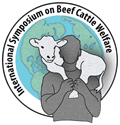Causes — and Prevention — of Livestock Accidents
Understand why accidents happen to help prevent them in the future.
MANHATTAN, Kan. (May 19, 2010) — Livestock handling specialist Jennifer Woods from Blackie, Alberta, Canada, shared some of the causes of accidents involving commercial trailers transporting cattle with attendees May 19 at the Emergency Preparedness Seminar that preceded the International Symposium on Beef Cattle Welfare.

There are interesting commonalities among livestock hauling accidents, Jennifer Woods says, adding that understanding those similarities may help prevent future occurrences.
Driver fatigue is the leading cause of these accidents, Woods said. “There is a lot of demand on these drivers. They are the only drivers who often sort, load and unload their own freight.”
Woods gathered data from more than 400 accidents involving livestock in North America. She cautioned that the findings cannot be considered scientific, since these incidents were typically from personal accounts or third-party informants and only account for about 25%-30% of all livestock accidents.
However, Woods said there were some interesting commonalities from the information gathered, including:
• 80% of incidents were single-vehicle accidents;
• 59% of incidents occurred between 12 a.m. and 9 a.m.;
• 56% involved cattle, and of those 70% involved feeder calves;
• 84% of trailers tipped over on the right-hand side; and
• 85% of incidents were connected to driver error.
To minimize accidents, Woods suggested truck drivers try to do the following:
• Be well-rested.
• Minimize driver distractions, such as eating, texting or talking on the cell phone.
• Use caution on corners. “Consider that if you take a corner too fast, and throw off the center of gravity of the cattle, the truck will start tilting,” she said, adding, “Livestock are different than any other load; especially cattle which have a higher center of gravity.” She reported that studies have shown a 5-degree angle is the point of no return for a trailer tipping. “Trailers are not very forgiving,” she said.
• Be careful on gravel roads and soft shoulders. “The end of the driveway is a common place for accidents because the back tires slip off the road into the ditch,” she noted.
Woods concluded that with planning, experience and caution, “Livestock trucking accidents can be prevented.”
The beef cattle welfare symposium was conducted on campus at K-State University May 19-21. For additional presentation summaries, return to the Meetings > Other Industry Meetings > News Coverage page of the API Virtual Library. For more about the symposium and an archive to the 2008 symposium, visit www.isbcw.beefcattleinstitute.org.
Editor's Note: This article was written under contract or by staff of Angus Productions Inc. (API), which claims copyright to this article. It may not be published or distributed without the express permission of API. To request reprint permission and guidelines, contact Shauna Rose Hermel, editor, at 816-383-5270.

